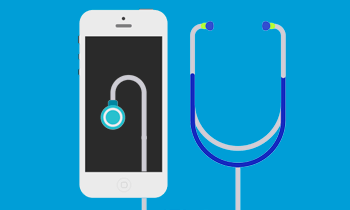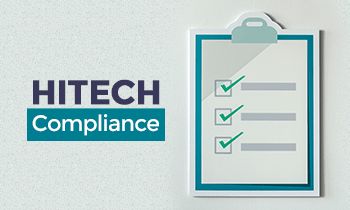SMART is an acronym coined for Substitutable Medical Applications and Reusable Technologies as a platform for Healthcare IT applications. It was started and run as a project by two non-profit institutions – Boston Children’s Hospital Computational Health Informatics program and the Harvard Medical School Department for Biomedical Informatics. It was started with an objective to develop an integrating platform enabling medical applications to be written once and run on a repeatable basis across different healthcare IT systems.
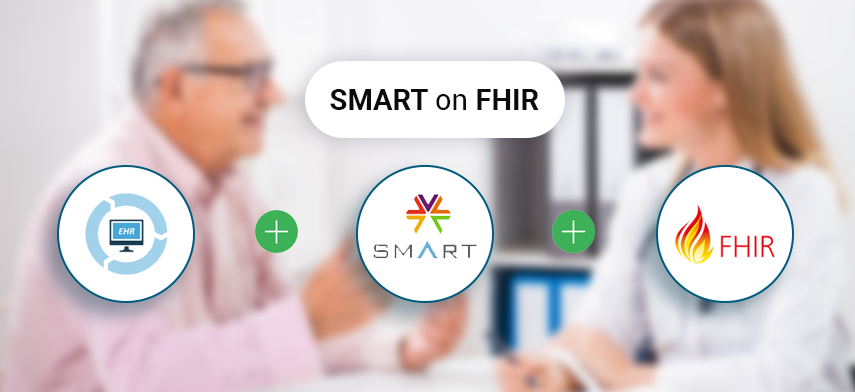
Extending the reach of Healthcare IT solutions to a wider Healthcare eco-system on SMART on FHIR!
What is FHIR? It is an acronym coined for Fast Healthcare Interoperability Resources which is a draft standard for data formats and data elements created by Health Level Seven International (HL7).
What is SMART on FHIR? It is a platform that strives to integrate healthcare IT systems by mediating access to FHIR on different systems to enable data access and exchange on any EHR (Electronic Health Records). The objective is the development of core data services (CDS) specification consisting of FHIR based API as well as security implementation guidelines.
SMART Compared to Previous Standards
The initial attempt is towards open and secure specification, made in the form of SMART classic. The adoption was not fast-paced as the platform had concerns and technical obstacles including a lack of large-scale adoptable API. Besides the SMART classic platform was focusing on some details like clinical data while ignoring others. The developers might have ignored some recommendations related to health IT standards community. Moreover, the technical and the problem of inadequacy of details led to its limited usage.
SMART on FHIR is a platform that provided many things such as the standards, security guidelines, platform to use, development and deployment apps, and also the standards that drive the widespread, flexible and secure adoption of Healthcare Information.
‘SMART on FHIR’ when considered as a standard had some predecessors. All of these contributed in one way or the other to the current standards.
The initial one was Clinical Document Architecture (CDA). This was based on the Reference Information Model (RIM) which was the information model for the healthcare industry also developed by HL7. This was lacking in the sufficiency of details so could not be effective. The C32 (a standard document reference from HL7) templates were helpful in providing more detailed guidance for the subsequent standards.
The second model was HL7’s version 2 and was attempted to be a messaging-based information exchange but suffered from inconsistencies across implementations although it overcame the detailing problem.
The third model was HL7’s version 3 which was also based on RIM model which provided clinical documents in a semantically consistent way. But version 3 was complex which led to incompatible documents and systems.
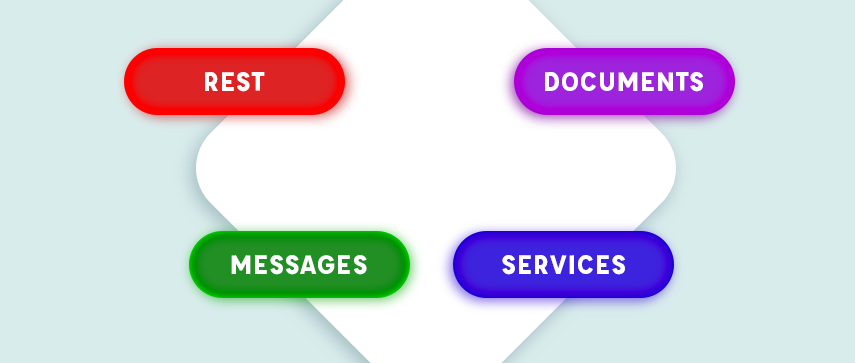
SMART on FHIR encompassed four interoperability paradigms, Viz., Documents, Services, Messages, and REST (Representational State Transfer); so SMART then supported a more consistent and more compatible information model.
Difference Between SMART and REDOX
REDOX Engine is also a technology platform for data exchange API for healthcare. Contrary to SMART which is open FHIR standards-based and from a non-profit group, REDOX is a profit organization that also provides an integration platform on FHIR.
There are a lot of similarities between SMART on FHIR as well as REDOX regarding patronage consisting of hundreds of hospitals using the respective platforms and both have their unique strengths in terms of EHR interoperability. However, there are some key differences:
Platform: There are some critical differences between SMART and REDOX as integrating platforms:
REDOX is a commercial platform that is powerful in its way to the extent of building integrations with technology vendors like EPIC and several others. REDOX is inherently not an open platform but has released platform support for SMART on FHIR.
SMART is an open platform and has adherence to the way all open platforms are built and operated. An open platform promises to provide extensive coverage of customers.
App Support: On the app support also SMART and REDOX have some key differences:
REDOX supports apps and also the vast amount of technology independence but its focus is on integration and the app development is left to the customers.
The objective of SMART is to take the information to the edge of the cloud, so supports several apps on mobile and web. There is skepticism about deviation from the standards due to various reasons while building the apps that could securely connect with the EHR via the platform.
SMART has dozens of apps already on its gallery that connect with various FHIR standard platforms and more are being built on the mobile as well as the web technologies.
Security: Both SMART and REDOX have high standards of security provisions for their respective platforms and are HIPAA compliant; however there are some differences:
REDOX has many security features such as being hosted on AWS with AES encrypted databases. REDOX is certified for HITRUST and has SOC type 2 certification. The security is taken care of by REDOX platform independent of EHR.
SMART aligns with open security standards such as OAuth 2.0 (Open Authorization version 2) and OIDC (OpenID Connect). The access is only brokered by SMART and authorization of connecting apps is done by the EHR. SMART defines how third-party apps launch within an EHR, how to determine which EHR user is interacting with the app, and what patient’s data is being accessed.
SMART and REDOX can be best compared with the duo of Java and Dot Net technologies with the former being based on open standards. Eventually, the openness prevailed for both platforms. A similar thing is shaping up to happen with the Healthcare domain also as the REDOX platform now supports SMART on FHIR.
Benefits of SMART

The advantage with SMART is that any app connecting with this platform can integrate with any healthcare IT system. The following are the benefits of a SMART on FHIR platform for various healthcare roles:
Healthcare App Developers: Developers can avail of free open source tools and resources for easy app creation. App gallery maintained by SMART can act as demonstrators of the capability. Integrating with EHR customers (on FHIR) comes at lesser complexity at a lesser cost.
Healthcare Providers and Patients: SMART platform enables develop apps that can link up healthcare professionals and patients with relative ease. It is possible for the Healthcare providers to extend the existing Healthcare IT system by the addition of new capabilities; for example trends and predictive patient analytics; besides it is possible to integrate data from new sources such as data from sensors, devices, and reports.
Healthcare Institutions: By regulating the flow of development of specific EHR projects it is possible to reap better ROI. It becomes possible to easily pick and choose the best of breed components into the existing systems. It also helps to derive competitive advantage from the existing library of innovative Healthcare apps.
Public Health: Particularly apps that deal with public health can be reshaped to have an impact on a broader audience. Specific directives can be propagated based on derived decisions without changing the EHR, especially during any outbreak incidents or in announcing guideline changes.
Functioning of SMART on FHIR
SMART on FHIR facilitates EHR interoperability with third-party apps by defining and facilitating connection with EHR; primarily it takes into three aspects for this via specifications:
Data Model/Data Exchange:

This is specified via the FHIR (HL7 draft) standards and related to data types, resources, and REST API. All data types are extensible including the primitive types; clinical data is represented as a resource in FHIR such as medical prescription, surgical procedure or a condition and many others. REST API provides the access to secure data on the EHR side once the user is granted access; API could handle many types of requests such as GET.
Security Protocols:
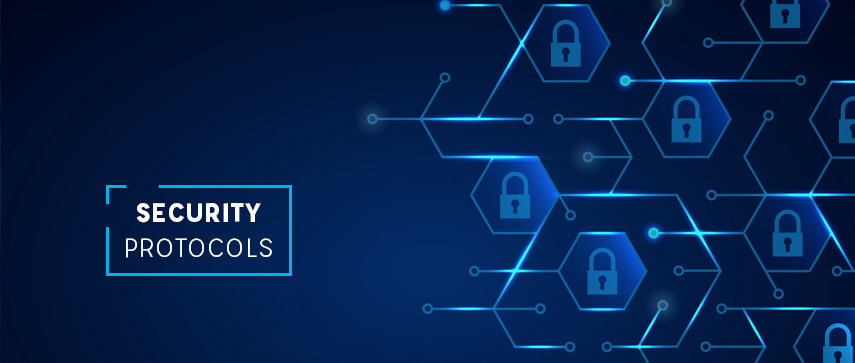
This is specified via Open Authorization protocols particularly OAuth 2.0 being the authorization standard and OIDC (ID token) being the identity standard. The protocol flow consists of a cycle starting with “Authorization request/grant, access token request/grant, and access to protected resources”. This is followed in both of the two client types: Public clients (HTML5/JavaScript, IOS applications) and Confidential clients (Web and Server side applications).
User Interface Access:
SMART facilitates two types of apps: EHR Embedded apps and Standalone apps. EHR embedded apps derive the UI based on the “launch” context, which depends on the type of access provided. Standalone apps do not have access to launch context so will need to have their rendering.
SMART platform brokers the access to the app from the EHR over a secure process. It uses the OAuth 2.0 process consisting of OIDC token to connect the app with the EHR. The token leads into a set of resources of which the access depends on the access provided. The token is like a single key that opens multiple boxes. The contents of any box may be given (EHR embedded apps) for short time or just shown (standalone apps). This depends on the scope defined for any token.
Popular Apps on SMART on FHIR – Case Studies
Herein presented are two case studies that demonstrate the versatility of the SMART on FHIR platform in building apps that extend and augment Healthcare IT solutions.

Extending the Reach of Healthcare IT solutions: The Geisinger and Merck solution is a twin app solution was developed on SMART on FHIR platform to help patients on two aspects, streamlining patient communication and regulating patient medication.
The Challenge: Any effective solution requires two aspects: understanding the problem and following a solution process. Understanding problems related to patients requires clear communication. The second part requires the process of solution which is typically the medication schedule for the patient. Right medicine at the right time would show positive effects and eventually lead to patient improvement. But how to ensure the patient and the doctor get the right communication between them? Also even if the communication is right how does this ensure the patient is on a recovery path?
The Solution: Geisinger and Merck provided a solution to handle all communications between the patient and the doctor by extending the EHR data. The first SMART on FHIR app (Family Caregiver) provides a blend of features such as communication, reminders, making notes, maintaining a short contact list which helps the patient maintain all aspects of communication-related to the treatment. The second SMART on FHIR app (Medtrue) helps the patient manage the medical data such as prescriptions (including changes, verifications and adherence) which is updated by the patient from time to time. These apps could connect with different relevant EHR to obtain and update data for the patient ensuring these two challenges are overcome. These effectively extend the scope of the EHR.
Prevention Is Better than Cure: Cerner and Duke Clinical Research found a way for doctors to encourage their patients to lead a healthier life by providing an app to warn them about the health condition.
The Challenge: Patients prone to heart problems face risks of varying magnitude and must take suitable care depending on the conditions leading to the problem. No single formula fits all patients. This requires a collection of the patient data and providing the risks they face if they don’t take precautions. The solution must gather data of only those patients that are prone to heart disease and provide an accurate assessment based on which the risk is evaluated.
The Solution: The SMART on FHIR app developed by the team with the name ASCVD Risk Calculator provides the patients not only the risk information as a numerical index based on health information gathered from the EHR data and provides precautions that may help them mitigate or minimize the risk by taking appropriate actions. Doing this for many patients accurately can be done by such an app which can pull data securely from the EHR system and provide the required information. This is indeed a handy tool for the doctors.
Conclusion
Extending the Healthcare IT solution to a vast population as possible was always a challenge. This aspect faced numerous problems related to technology, standards, and disparate systems. But SMART on FHIR is an extremely promising and fruitful step towards overcoming these problems and eventually lead to superior Healthcare IT systems that have far broader reach.
SMART on FHIR is a progressive, successful and pervasive platform that is making waves. Through the SMART CDS Hooks and the SMART Genomics initiatives, the SMART project is defining the next generation of FHIR based standards to aid the integration of clinical decision support into provider workflows and the clinical use of genomic data.
Healthcare is a serious and a vast subject. It requires expertise in IT, Healthcare domain knowledge and dedicated resources to get the right solution. At Mobisoft Infotech we have 8+ years of expertise, 200 plus developers and 25+ healthcare solutions as our background. We are trusted partners for healthcare app development on state-of-the-art platforms such as SMART on FHIR.
Author's Bio

Shailendra Sinhasane (Shail) is the co-founder and CEO of Mobisoft Infotech. He has been focused on cloud solutions, mobile strategy, cross-platform development, IoT innovations and advising healthcare startups in building scalable products.




